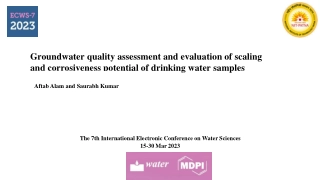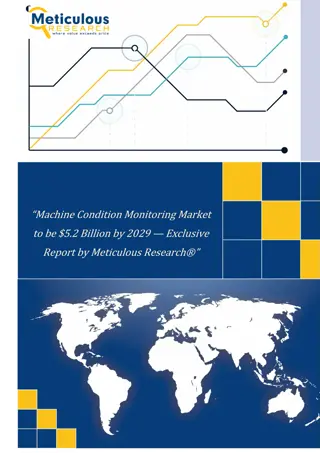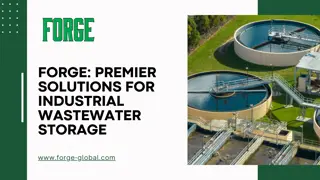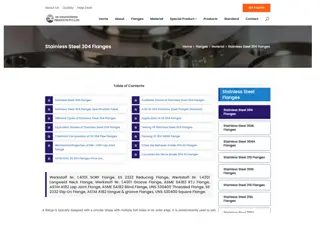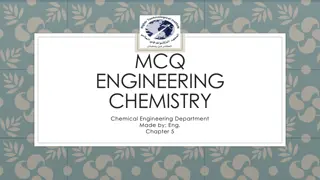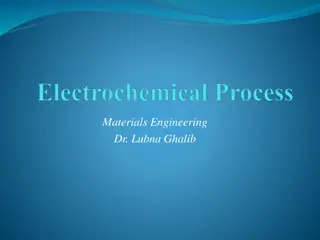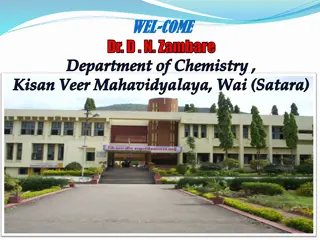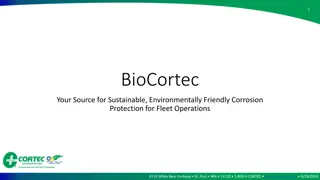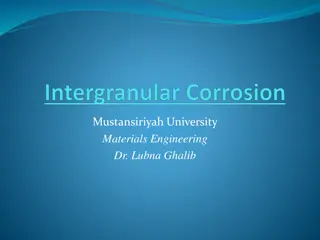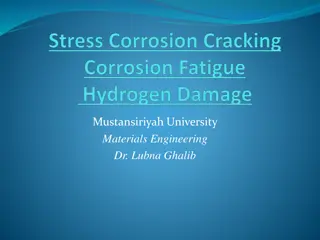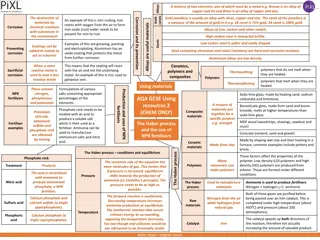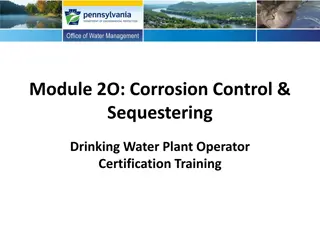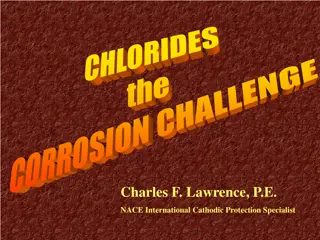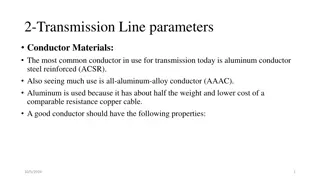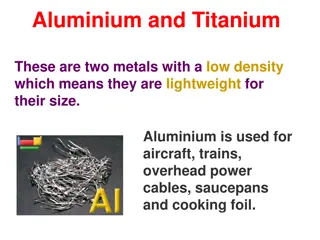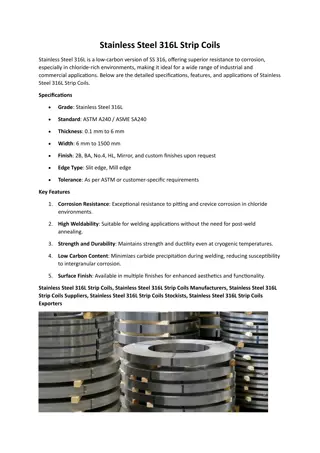
Understanding Corrosion: Types, Prevention, and Factors
Discover the definition of corrosion, its impact on metals, factors affecting corrosion rates, and methods for prevention. Learn about the Deal Grove model for predicting oxide layer formation and more in this comprehensive guide.
Download Presentation

Please find below an Image/Link to download the presentation.
The content on the website is provided AS IS for your information and personal use only. It may not be sold, licensed, or shared on other websites without obtaining consent from the author. If you encounter any issues during the download, it is possible that the publisher has removed the file from their server.
You are allowed to download the files provided on this website for personal or commercial use, subject to the condition that they are used lawfully. All files are the property of their respective owners.
The content on the website is provided AS IS for your information and personal use only. It may not be sold, licensed, or shared on other websites without obtaining consent from the author.
E N D
Presentation Transcript
StudyMafia.Org Corrosion Submitted To: Submitted By: Studymafia.org Studymafia.org
Table Contents Definition Introduction Facts Affecting Corrosion Rate of Corrosion Types of Corrosion Prevention of Corrosion Conclusion 2
Definition Corrosion is one of the most common phenomena that we observe in our daily lives. You must have noticed that some objects made of iron are covered with an orange or reddish- brown coloured layer at some point in time. 3
Introduction Cossorion, in general, is a process through which refined metals are converted into more stable compounds such as metal oxides, metal sulfides, or metal hydroxides. Likewise, the rusting of iron involves the formation of iron oxides via the action of atmospheric moisture and oxygen. If we look at the science behind corrosion then we can say that it is a spontaneous/ irreversible process wherein the metals turn into a much stable chemical compound like oxides, sulphides, hydroxides, etc. 4
Factors Affecting Corrosion 1. Exposure of the metals to air containing gases like CO2, SO2, SO3 etc. 2. Exposure of metals to moisture especially salt water (which increases the rate of corrosion). 3. Presence of impurities like salt (eg. NaCl). 4. Temperature: An increase in temperature increases corrosion. 6
Factors Affecting Corrosion 5. Nature of the first layer of oxide formed: some oxides like Al2O3 forms an insoluble protecting layer that can prevent further corrosion. Others like rust easily crumble and expose the rest of the metal. 6. Presence of acid in the atmosphere: acids can easily accelerate the process of corrosion. 7
Rate of Corrosion The Deal Grove model is often used to describe the formation of an oxide layer. This model helps in predicting and controlling oxide layer formation in a lot of diverse situations. Alternatively, the weight loss method is also used to measure corrosion. In this method, a clean weighed piece of the metal or alloy is exposed to the corrosive environment for a certain duration. 8
Rate of Corrosion The Deal Grove model is often used to describe the formation of an oxide layer. This model helps in predicting and controlling oxide layer formation in a lot of diverse situations. Alternatively, the weight loss method is also used to measure corrosion. In this method, a clean weighed piece of the metal or alloy is exposed to the corrosive environment for a certain duration. 9
Rate of Corrosion The rate of corrosion (R) is calculated as; Where, k = constant, W = weight loss of the metal in time t, A = surface area of the metal exposed, is the density of the metal (in g/cm ). 10
Types of Corrosion Crevice Corrosion Whenever there is a difference in ionic concentration between any two local areas of a metal, a localized form of corrosion know as crevice corrosion can occur. In a simple instance, this form of corrosion mostly occurs in confined spaces (crevices). Examples of areas where crevice corrosion can occur are gaskets, the undersurface of washers, and bolt heads. 11
Types of Corrosion Stress Corrosion Cracking Stress Corrosion Cracking can be abbreviated to SCC and refers to the cracking of the metal as a result of the corrosive environment and the tensile tress placed on the metal. It often occurs at high temperatures. 12
Types of Corrosion Intergranular Corrosion Intergranular corrosion occurs due to the presence of impurities in the grain boundaries that separate the grain formed during the solidification of the metal alloy. It can also occur via the depletion or enrichment of the alloy at these grain boundaries. 13
Types of Corrosion Galvanic Corrosion When there exists an electric contact between two metals that are electrochemically dissimilar and are in an electrolytic environment, galvanic corrosion can arise. It refers to the degradation of one of these metals at a joint or at a junction. 14
Types of Corrosion Pitting Corrosion Pitting Corrosion is very unpredictable and therefore is difficult to detect. It is considered one of the most dangerous types of corrosion. It occurs at a local point and proceeds with the formation of a corrosion cell surrounded by the normal metallic surface. 15
Types of Corrosion Uniform Corrosion This is considered the most common form of corrosion wherein an attack on the surface of the metal is executed by the atmosphere. The extent of the corrosion is easily discernible. This type of corrosion has a relatively low impact on the performance of the material. 16
Types of Corrosion Hydrogen Grooving This is a corrosion of the piping by grooves that are formed due to the interaction of a corrosive agent, corroded pipe constituents, and hydrogen gas bubbles. The bubbles usually remove the protective coating once it comes in contact with the material. 17
Types of Corrosion Metal Dusting Metal dusting is a damaging form of corrosion that occurs when vulnerable materials are exposed to certain environments with high carbon activities including synthesis gas. The corrosion results in the break-up of bulk metal to metal powder. 18
Types of Corrosion Microbial Corrosion Microbial corrosion which is also known as microbiologically influenced corrosion (MIC), is a type of corrosion that is caused by microorganisms. The most common one is chemoautotrophs. 19
Types of Corrosion High-temperature Corrosion High-temperature corrosion as the name suggests is a type of corrosion of materials (mostly metals) due to heating. Chemical deterioration of metal can occur due to a hot atmosphere that contains gases such as oxygen, sulfur, or other compounds. 20
Prevention of Corrosion Preventing corrosion is of utmost importance in order to avoid huge losses. The majority of the structures that we see and use are made out of metals. This includes bridges, automobiles, machinery, household goods like window grills, doors, railway lines, etc. 21
Prevention of Corrosion Electroplating Galvanization Anodization Passivation Biofilm Coatings Anti-Corrosion Protective Coatings Painting and Greasing Use of Corrosion Inhibitor or drying agents Periodic cleaning of metal surface 22
Conclusion Corrosion is usually an undesirable phenomenon since it negatively affects the desirable properties of the metal. For example, iron is known to have good tensile strength and rigidity (especially alloyed with a few other elements). However, when subjected to rusting, iron objects become brittle, flaky, and structurally unsound. 23
Thanks To StudyMafia.org

